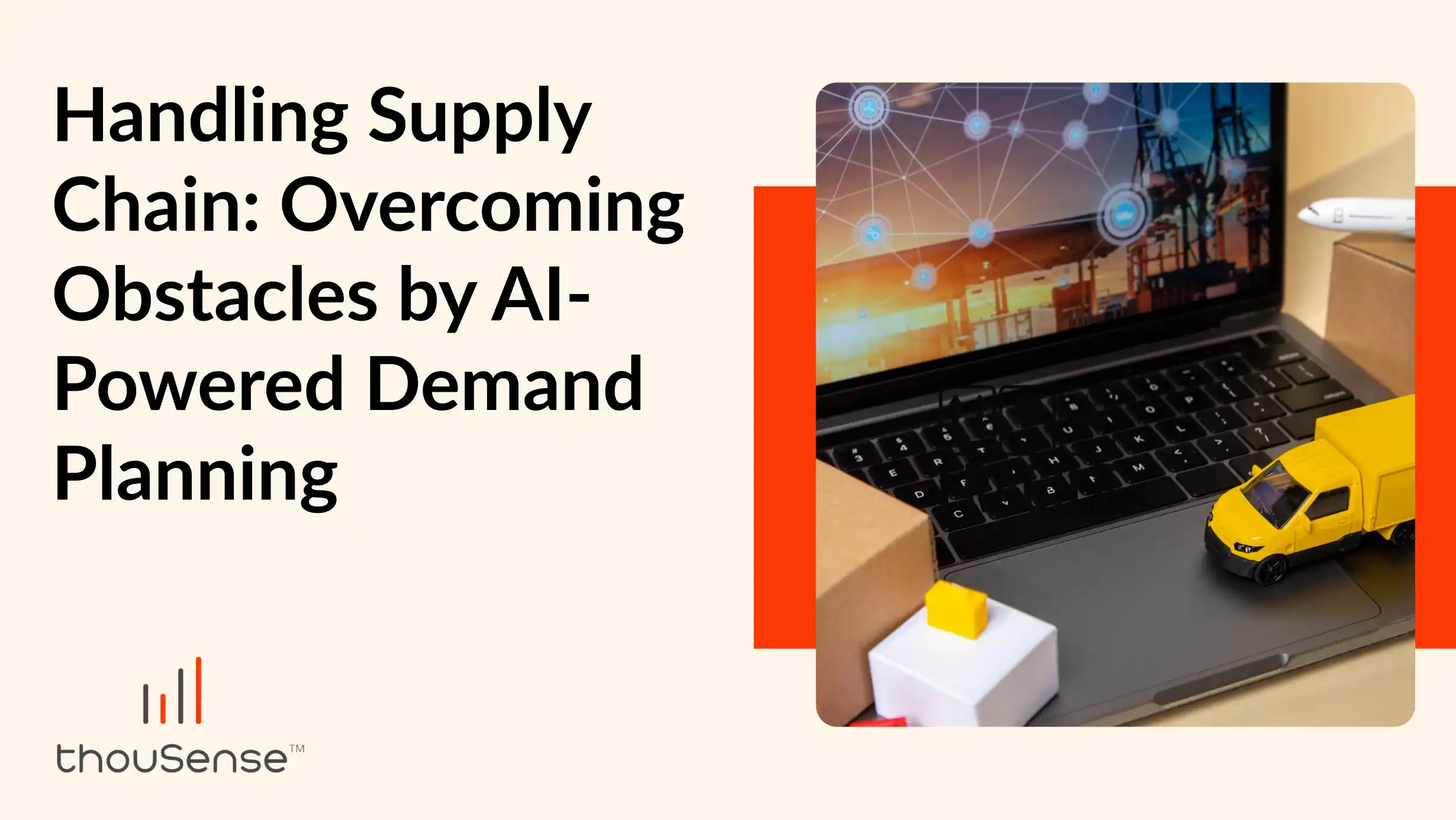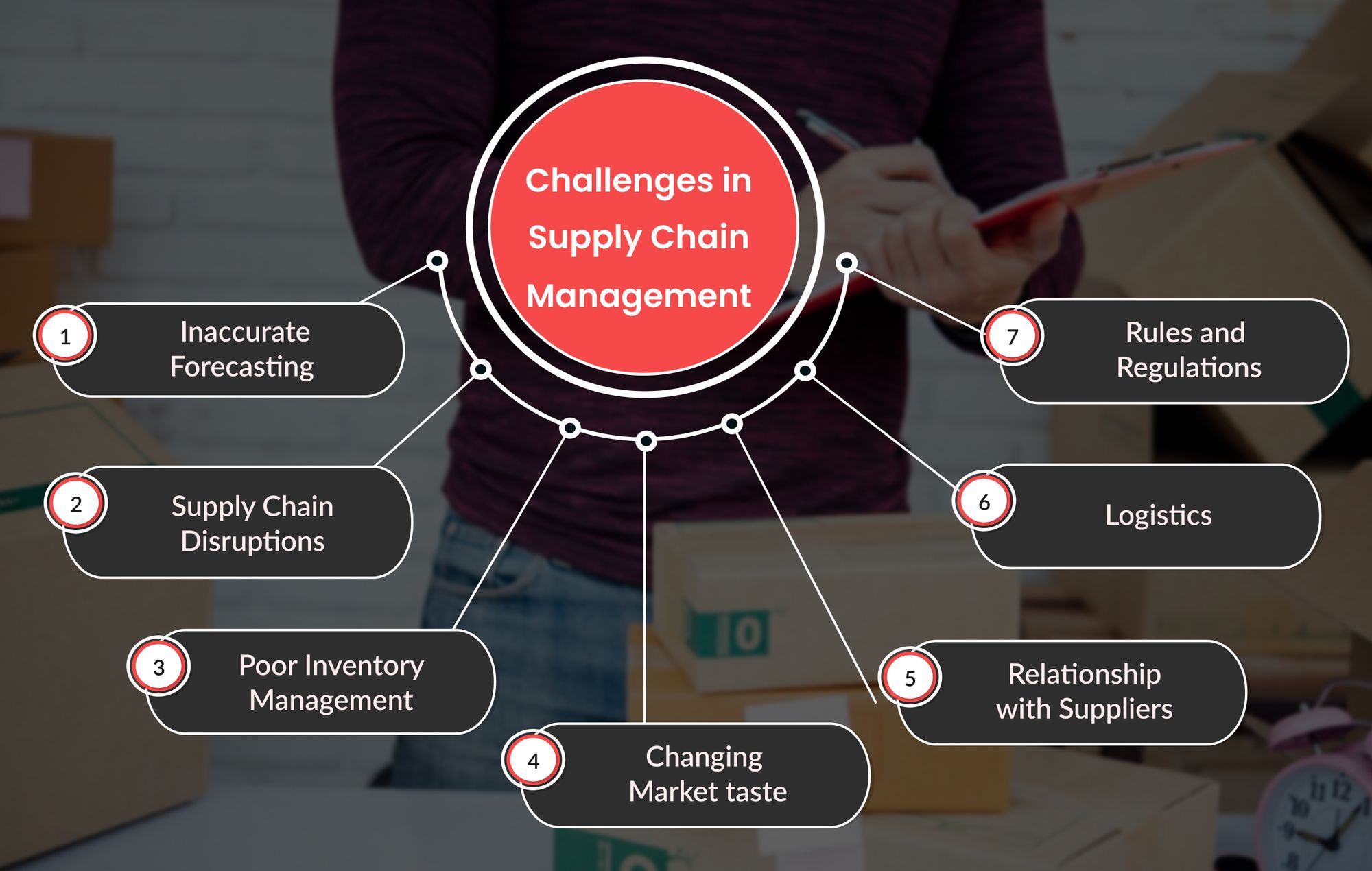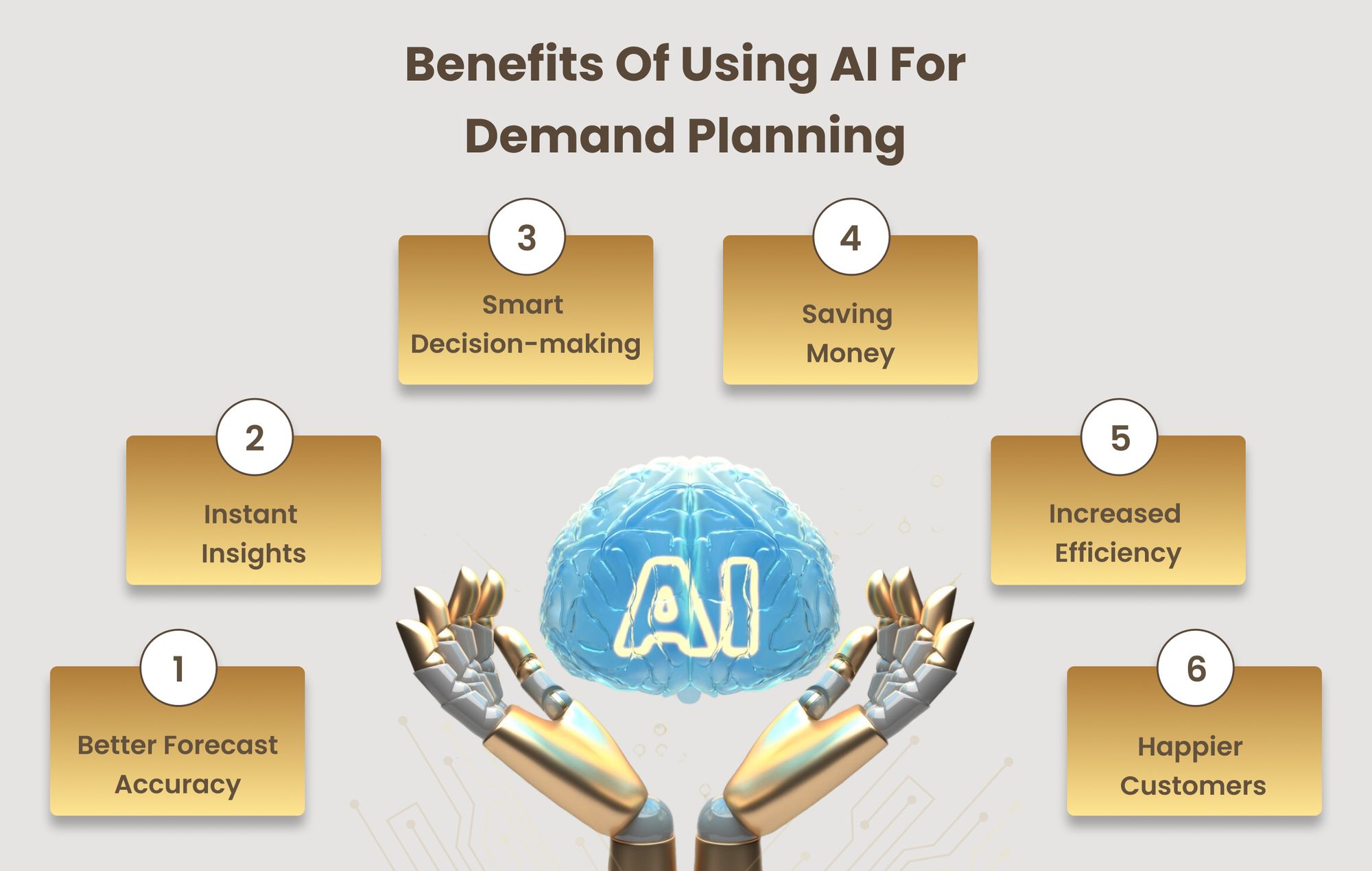Handling Supply Chain: Overcoming Obstacles by AI-Powered Demand Planning

Introduction
Did you know that businesses lose about $1.1 trillion each year because of bad supply chain management, causing stockouts and overstocked inventory? As stated by Conveyco, this loss shows how important it is to manage the supply chain well.
Supply chain management involves coordinating activities like sourcing, manufacturing, and delivering products to customers, and it's crucial for business success.
However, traditional demand planning methods often struggle to keep up with today's fast-changing market demands, resulting in inefficiencies and missed opportunities.
In this blog, we'll talk about the problems with planning methods and how using AI can make the supply chain work better.
Common Challenges in Supply Chain Management

● Inaccurate Forecasting: Mistakes in forecasting can cause overstocking or under-stocking of inventory. Different industries have error rates between 3.4% and 10.4%, according to the Survey of Professional Forecasters.
● Supply Chain Disruptions: According to BCI Supply Chain Resilience Report 2023, Supply chain disruptions can cost a business up to 84.6% of its operational expenses.
● Poor Inventory Management: Poorly managing inventory can lead to extra costs and items becoming outdated. About 34% of businesses accidentally sold products that were out of stock, causing delays. Also, 43% of small businesses don't keep track of their inventory regularly.
● Changing Market taste: Some companies find it hard to respond to changes in demand. Changing inventory according to consumer demand is crucial for any business.
● Relationship with Suppliers: Managing relationships with suppliers can be tough. Issues like late deliveries, quality problems, and communication barriers can come up.
● Logistics: Transportation logistics, like route planning and choosing carriers, are challenging. Delays and rising fuel costs can disrupt supply chain operations.
● Rules and Regulations: Keeping up with rules and regulations is hard. It's complex and takes a lot of time, and if it's not done right, there can be legal and financial risks.
Impact of Supply Chain Inefficiencies on Businesses
● Supply chain problems can make operational expenses go up by a lot, even up to 84.6%. (Source)
● If demand forecasting is poor, it can make revenue drop. For example, because of Brexit, 28% of businesses lost an average of 18% of their revenue in a year. (Source)
● Late deliveries or not having enough products can hurt a company's reputation. For example, bad weather affects the logistics cost for 62% of companies and reputation. (Source)
● Supply chain issues might make customers less loyal.
● Inefficiencies can stop growth opportunities.
The Role of Demand Planning in Supply Chain Optimization
Demand planning plays a crucial role in supply chain optimization by ensuring that the right products are available in the right quantities at the right time. For example, in the fast-moving consumer goods (FMCG) industry, companies like Procter & Gamble use demand planning to anticipate what customers want, like diapers or laundry detergent. This helps them schedule production better, save on inventory costs, and keep their products on store shelves.
Now let’s see how demand planning aligns supply with customer demand
Role of Demand Planning in Aligning Supply with Customer Demand:
● Forecasting customer demand accurately is important for businesses. It helps them predict how much of their products or services customers will want in the future. By doing this well, businesses can make sure they have enough stock to meet demand without having too much extra. This means they can avoid situations where they run out of products or end up with too much inventory that they can't sell.
● Accurate forecasting also lets businesses plan their production schedules better. They can make sure they're making enough of their products at the right times to match what customers are likely to buy. This helps them avoid wasting resources or having machines sitting idle when they don't need to be used.
● When businesses get their forecasting right, it makes customers happy. They can rely on the business to have what they want when they want it. This leads to satisfied customers who keep coming back.
● Good forecasting also saves businesses money. By keeping just the right amount of inventory, they don't tie up too much money in storage costs or risk losing money on products that go out of style or expire.
● Knowing what customers will want in the future also helps businesses plan where to put their resources. They can use their materials, workers, and production space more efficiently, which means less waste and more profit.
● Finally, accurate forecasting gives businesses insights into making big decisions. They can use this information to decide what products to focus on, how to market them, and even whether to expand their operations. So, getting demand forecasting right doesn't just help with day-to-day operations, it shapes the future of the business.
Impact of Demand Forecasting on Supply Chain:
|
Factors |
Details |
|
Inventory Management |
Accurate
forecasting minimizes stockouts and reduces carrying costs by optimizing
inventory levels. |
|
Production Scheduling |
Forecasting
demand enables efficient allocation of resources and minimizes idle time in
production processes. |
|
Customer Satisfaction |
Customer
satisfaction and loyalty are boosted when products are readily available. |
|
Cost Reduction |
Efficient
demand planning minimizes wastage and reduces costs associated with excess inventory. |
|
Resource Allocation |
Forecasting
supports optimal utilization of resources, including raw materials and
production capacity. |
|
Decision-making |
Informed
decisions based on demand
forecasts drive strategic growth
and competitive advantage. |
|
Supply Chain Performance |
Effective
demand planning enhances the overall efficiency and responsiveness of the
supply chain. |
|
Revenue Generation |
Maximizing
sales opportunities through accurate forecasting leads to increased revenue
and profitability. |
Overcoming Obstacles By AI-Powered Demand Planning
AI-powered demand planning means using artificial intelligence to improve forecasting of product or service demand. With AI, businesses can use algorithms to analyze data, find patterns, simulate past sales, and predict future demand accurately. This helps them make smart production decisions, ordering, and managing inventory, making their supply chains work that better.
The benefits of using AI for demand planning are:

● Better Forecast Accuracy: AI learns from past data, making predictions more accurate over time. This reduces the chances of wrong forecasts, which means less risk of having too much or too little inventory.
● Instant Insights: AI tools give quick insights into demand patterns, so businesses can react fast to changes in the market. This helps them adjust production, reorder stock, and change strategies quickly, making them more flexible and competitive. AI-driven forecasting engines can automate up to 50% of workforce-management tasks, leading to cost reductions of 10 to 15% (Source)
● Smart Decision-making: AI models can predict changes in demand by looking at many factors like market trends and consumer behavior. By seeing risks and opportunities early, businesses can handle supply chain problems better and take advantage of new trends.
● Saving Money: According to McKinsey Digital, using AI for forecasting can cut errors by 30 to 50% in supply chains. This means a 65% drop in lost sales from not having enough stock and a 10 to 40% cut in warehousing costs. Also, AI tools can automate tasks, saving on labor costs.
● Increased Efficiency: AI tools make order processing faster, improving how quickly orders are fulfilled. They also find links between demand and outside factors, helping businesses work even better.
● Happier Customers: By predicting demand accurately and keeping products available, businesses make customers happier and more loyal. Fast insights help meet customer expectations, making for good experiences and more sales.
Using AI for demand planning has clear benefits: better predictions, quick insights, smart choices, cost savings, efficiency, and happier customers. With AI, businesses can make their supply chains work better, stay competitive, and grow in today's fast-changing market.
Comparison Between Traditional Demand Planning And AI-Driven Demand Planning
|
Aspect |
Traditional
Demand Planning |
AI-Driven
Demand Planning |
|
Methodology |
Relies
heavily on historical data and manual analysis. |
Utilizes
advanced algorithms, machine learning, and predictive analytics to analyze
vast datasets and identify patterns. |
|
Accuracy |
Accuracy
may vary due to reliance on manual analysis and historical data. |
Offers
improved accuracy over time as AI algorithms continuously learn and adapt
from new data, resulting in more precise demand forecasts. |
|
Speed |
Manual
processes can be time-consuming, leading to delays in decision-making. |
Provides
real-time insights into demand patterns, enabling businesses to respond
swiftly to market changes and make timely decisions. |
|
Flexibility |
Limited
flexibility in adjusting to sudden changes in demand or market conditions. |
Offers
greater flexibility and agility in adapting production schedules, inventory
levels, and strategies based on real-time demand insights. |
|
Efficiency |
Processes
may be inefficient due to manual data analysis and decision-making. |
Enhances
operational efficiency by automating tasks, streamlining processes, and
optimizing supply chain operations. |
|
Insights |
Relies
on human interpretation of data, which may overlook subtle patterns or
trends. |
Offers
deeper insights into demand patterns and market dynamics through advanced
data analysis and predictive modeling. |
|
Competitive Advantage |
May
lag behind competitors who adopt more advanced demand planning techniques. |
Provides
a competitive edge by enabling businesses to respond faster to market
changes, optimize operations, and deliver superior customer experiences. |
Case Studies
1. H&M's AI Solution for Better Clothing Demand Prediction
Introduction:
H&M, a top clothing retailer globally, faced a common problem: predicting what customers want. This challenge led to either having too much or too little stock, affecting customer happiness and profits.
Problem:
Like many fashion stores, H&M struggled to accurately predict demand for their clothes. Using old methods based only on past sales often caused shortages or too much stock, causing problems in their supply chain and customer satisfaction.
Solution:
H&M found a solution by teaming up with an AI company. They used machine learning to analyze various data, such as:
● Social media trends to see what styles people liked.
● Weather forecasts to predict which clothes might be popular based on the weather.
● Economic data to understand how people's spending habits might change.
Results:
The new system led to:
● Better predictions: H&M could forecast demand more accurately.
● Less shortages: Customers were more likely to find the clothes they wanted.
● Less excess stock: H&M saved money on storage and didn't have to discount unsold items as much.
● Better planning: With more accurate forecasts, H&M could plan their production better and have the right clothes at the right time.
● Faster reactions: H&M could respond quickly to new trends, making them more competitive.
Conclusion:
H&M's adoption of AI for demand forecasting made their supply chain more efficient. This led to happier customers, more profit, and a stronger position in the fashion world. (Source)
2. Walmart: Leveraging AI for Smarter Inventory Management
Challenge:
Walmart, the world's biggest retailer, handles a massive amount of stock across its many stores, serving diverse customers. But traditional methods for predicting demand struggled to keep up, causing problems like:
● Stockouts: Missing out on sales when popular items ran out.
● Excess inventory: Overstocking, wasting space and money.
● Discounts and markdowns: Selling items at a loss to clear excess stock.
Solution:
Walmart turned to AI for help. They introduced a system that uses AI to forecast demand. It looks at a lot of data, including:
● Past sales: Understand how much of each item sells normally.
● Local weather: Predicting how weather affects what people demand (like sunscreen in summer).
● Local events: Anticipating surges in demand associated with specific occasions, like holidays.
● Social media: Identifying trends on social media to understand consumer preferences.
Results:
The AI system helped Walmart in several ways:
● Reduced stockouts by 10-15%: Better forecasts meant shelves were stocked with what customers wanted.
● Lowered inventory costs: By not overstocking, Walmart saved money on storage.
● Improved promotions: With better forecasts, Walmart could run promotions more effectively, saving money.
Overall Success:
Walmart's AI system made its supply chain more efficient and responsive. This led to:
● Happier customers: They were more likely to find what they wanted in stock.
● Higher profits: By saving on storage and running better promotions, Walmart made more money.
● Better decisions: AI gave Walmart insights to make smarter choices about what to stock and how to price it. (Source)
3. Tesla: AI-driven Production Planning for Electric Vehicles
Challenge:
Tesla, a leading electric vehicle (EV) manufacturer, faces a changing market with unpredictable demand for different car models. Traditional forecasting methods based on past sales data struggled to keep up with these changes. This led to:
● Production issues: Trouble in getting the right parts to meet demand for specific car models.
● Late deliveries: Customers waiting longer than expected for their Teslas because of production problems.
● Missed sales: Not being able to take advantage of sudden increases in demand for certain models.
Solution:
To address these challenges, Tesla implemented an AI-powered demand forecasting system. This system analyzes various data sources, including:
● Customer pre-orders: Predicting demand based on pre-orders placed online.
● Production data: Identifying potential issues in production and optimizing schedules.
● Market research: Analyzing competitor products and trends in the EV market.
● Social media: Understanding customer interest and potential demand for upcoming models.
Results:
The AI system brought several improvements:
● Better production: Identifying issues and optimizing schedules led to smoother production.
● Fewer delays: With better forecasts, Tesla could ensure timely deliveries by having the necessary parts.
● More sales: Reacting quickly to changes in demand helped Tesla capitalize on new opportunities.
Overall Success:
Tesla's AI-based demand planning improved its production and customer satisfaction. This led to:
● Happier customers: Shorter wait times and more choices improved the overall experience.
● Competitive edge: Tesla's ability to respond quickly to market changes kept them ahead.
● Efficient resource use: Clearer demand insights helped Tesla allocate resources effectively. (Source)
These case studies highlight how AI-driven demand planning can revolutionize businesses across industries, providing valuable insights and competitive advantages.
Conclusion
In conclusion, using AI for demand planning can help businesses improve their supply chains. It makes predictions better, helps spot trends faster, and ensures they have enough of the right products when customers want them. By looking at examples from companies like H&M, Walmart, and Tesla, we see how AI makes a big difference. If you want to make your supply chain work better too, consider exploring AI options for demand forecasting.